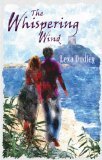Hannah Fielding's Blog, page 109
March 2, 2014
Tuscany week: How I left my heart in Tuscany
When I first visited Tuscany I fell in love. So much so that when I was writing The Echoes of Love, whose action opens in Venice, Italy, I knew there was only one place I could situate the hero’s country retreat: Tuscany, the perfect backdrop for romance.
The Tuscan landscape is simply breathtaking – the vineyards, the cypress trees, the colourful renders and roof tiles of the buildings. Just take a look at this Pinterest board I put together while researching my novel:
Follow Hannah Fielding’s board Tuscany on Pinterest.
Don’t you just long to dive into one of these pictures? Truly my hero Paolo is lucky to live in such a place. To modify a line by one of my favourite poets, Elizabeth Barrett Browning, ‘Tuscany is crammed with heaven…’
Of course, I am someone who very much thrives in inspirational surroundings – you may say they feed my soul. Having grown up in a house overlooking the very bluest of oceans beneath the very bluest of skies, I have always admired nature; have always longed to be connected to it and somewhat lost in grey, concrete cityscapes. So I was bound to feel an affinity for a place such as Tuscany.
But it is more than the landscape that captured my heart: it is the people, and the unique culture they have created in this ‘nation within a nation’. In particular, the region is infused with the legacy of the Renaissance that was born there. This was the land of artists Donatello, Botticelli, Leonardo da Vinci and Michelangelo; of writers Dante and Petrarch. In this region lie so many important and historic cities, from Florence to Pisa, Siena to Volterra.
American poet Oscar Fay Adams put it best in his poem ‘A Tale of Tuscany’:
Tuscany, land of fierce hates and wild loves and of limitless passions.
Such a perfect description of one of my favourite places in the world. If, like me, you are a romantic and a Tuscan aficionado then I highly recommend Adams’ narrative poem, which opens:
An Old-World tale. Who reads perchance
May deem it dull or idly told,
Preferring latter-day romance
Where well trained hearts their loves unfold.
You can read ‘A Tale of Tuscany’ online here.
February 28, 2014
Book review: Snowflakes and Silver Linings by Cara Colter
From the blurb:
A wedding guest from her past…
After a rocky year, Casey Caravetta pulls herself together and puts on a smile for her best friend’s Christmas Eve wedding. However, she hadn’t expected to see Turner Kennedy, the first man to break her heart.
Special Forces commando Turner is now hard, dark and dangerous, tortured by his experiences of war. Coming face-to-face again with beautiful Casey is a painful reminder of the path he might have taken.
Back then they were living on borrowed time, but now—with a sprinkling of holiday magic—they have a another chance…if only they’re prepared to believe it!
A great little seasonal read.
For me, the strength of this book lies very much in the characterisation – both Casey and Turner are multi-faceted characters whom I was keen to unravel. So much of their pasts holds them back, and the book is essentially a journey in a microcosm that offers them the opportunity to shed their regrets and the legacies of their childhoods and early adult lives, and find happiness at last – not alone, but together.
The writer’s style makes it easy to get inside the characters’ minds and really understand them, and I liked how much emphasis she put on exploring their emotional plains.
I very much liked the backdrop of the Gingerbread Inn, and the fact that this story interweaves with two other books whose protagonists appear in Snowflakes and Silver Linings as Casey’s best friends.
Plot-wise, this isn’t a long book so there isn’t much scope for lots of action and twists and turns, but I liked the story as it stood, especially a moment of high-drama that led to the coming together of the characters. And the ending is bound to leave you with that happy, satisfied feeling you seek from a romance book of this nature.
In conclusion, if you like seasonal Harlequin romances, this one is sure to be a favourite on your shelf – well worth the read.
I was offered this book in exchange for a fair review via NetGalley.
Snowflakes and Silver Linings is available now from Amazon; click on the book cover below to visit the store.
February 26, 2014
The lonely writer: Tips for overcoming isolation and finding inspiration
 When I say ‘a writer writing’ to you, what image flits into your mind? You may see a person bashing away at a typewriter, or scrawling frenetically in a notebook, or staring vacantly into space surrounded by balled-up sheets of paper, or glaring at a blinking cursor on an empty computer screen. But however you picture the writer, in whatever mood, with whatever tools, in whatever setting, most likely there is just one person in your vision.
When I say ‘a writer writing’ to you, what image flits into your mind? You may see a person bashing away at a typewriter, or scrawling frenetically in a notebook, or staring vacantly into space surrounded by balled-up sheets of paper, or glaring at a blinking cursor on an empty computer screen. But however you picture the writer, in whatever mood, with whatever tools, in whatever setting, most likely there is just one person in your vision.
The writer, so often, writes alone.
That the pursuit of writing is a lonely one is well documented. In his memoir Isaac Asimov wrote:
Writing is a lonely job. Even if a writer socializes regularly, when he gets down to the real business of his life, it is he and his type writer or word processor. No one else is or can be involved in the matter.
And upon accepting the Nobel Prize for literature, Ernest Hemingway said:
Writing, at its best, is a lonely life. Organizations for writers palliate the writer’s loneliness, but I doubt if they improve his writing. He grows in public stature as he sheds his loneliness and often his work deteriorates. For he does his work alone and if he is a good enough writer he must face eternity, or the lack of it, each day.
But must we writers just accept isolation? It’s no hardship to do so sometimes, when solitude is essential to finding the focus to write. But let us not forget that all good writing has one critical element at its heart: people. We write about people, for people. And thus it follows logically that should we spend too much time away from people, we risk losing touch and our writing suffering consequently.
People bring comfort and cheer. People bring connection. People bring inspiration. People bring energy and colour and life.
Here, then, are some suggestions for writers who are feeling the effects of too much time wandering and wondering alone in their imaginations.
Join a writing group. All kinds of groups exist to inspire and help writers, both online and offline. Look for one that’s specific to your genre, with friendly members whose aim is to collaborate and support, not compete and criticise. If you can’t find a group that’s a good fit for you, start one of your own – Goodreads, for example, makes it very easy to set up a shared interest group. Alternatively, if the thought of sharing your writing is abhorrent, join a reading club instead.
Find a writing buddy. A buddy can fulfill the roles of muse, sounding board, critic and champion – a sort of personal trainer for the literary world. Your styles and genres and personal aims can differ widely; all that matters is having a friend with whom you can share all the highs and lows of the writing process.
Co-author. The ultimate companionship for the writer. Co-authoring comes with its challenges, such as agreeing on content, divvying up the work and then sharing the credit; but there are numerous benefits, not least of which is an extra pair of hands with all the work of writing, from idea generation and drafting through to marketing.
Write among people. My favourite by far! Too often the four walls close in after several hours of writing. Going anywhere populated – a café, a library, a book store, the park – provides a much-needed change of scene and a connection to the living, breathing world. You don’t have to talk to anyone if you don’t want to; you can stay immersed in your story world. Or you can put down your pen, sit back, people-watch and let your imagination take flight.
If you are exceptionally lucky, some enterprising soul in your local area, perhaps at the library or an arts centre, has married all four of these elements in creating a writing hub: a place you can go to when you want to connect to other writers. Sadly, these hubs are few and far between. Perhaps one day someone will formalise them, and every city and town will have such a place.
I hope so. Because I’m not sure that I agree with Hemingway that bringing together writers does nothing to improve their craft. John Donne’s words echo in my mind:
No man is an island,
Entire of itself,
Every man is a piece of the continent,
A part of the main.
We writers write of mankind. And so, as Donne says, we must be ‘involved in mankind’.
February 25, 2014
Literary Venice Week: John Ruskin’s The Stones of Venice
John Ruskin (1819–1900) was a man of many passions: an art critic, a patron, a draughtsman, a painter, a philanthropist and a reformer. And he was a man who loved, loved Venice.
He channeled all his admiration into a three-volume collection of essays on Venetian art and architecture entitled The Stones of Venice. The collection was widely read and highly influential; one essay in particular, ‘The Nature of Gothic’, was shared in many other anthologies and is commonly cited as a major contributor to the great Gothic Revival of the nineteenth century.
The Stones of Venice is essentially a fabulously detailed description of Venice in Ruskin’s time. Take the following extract:
And now come with me, for I have kept you too long from your gondola: come with me, on an autumnal morning, to a low wharf or quay at the extremity of a canal, with long steps on each side down to the water, which latter we fancy for an instant has become black with stagnation; another glance undeceives us, –it is covered with the black boats of Venice. We enter one of them, rather to try if they be real boats or not, than with any definite purpose, and glide away; at first feeling as if the water were yielding continually beneath the boat and letting her sink into soft vacancy.
So visual and evocative – it’s little wonder Ruskin’s writing inspired a wealth of writers to visit Venice and write there.
Thanks to the marvels of modern technology you can watch a virtual movie that brings to life Ruskin reading a part of his work. The words, when you listen, are as fluid and lulling and stirring as poetry.
February 24, 2014
Literary Venice Week: Recommended literary companion
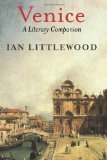

Here’s a wonderful book for anyone who, like me, is fascinated by Venice’s rich literary history. I especially loved the walking tours outlined in the book – a wonderful way to explore the city.
From the blurb:
Venice has always attracted an extraordinary range of writers – pious and impious, earnest and frivolous, enthusiastic and hostile. And because so much of the city has remained unchanged, their words have a powerful hold on our imagination. To walk through Venice is to enter an extravagant theatre where we can chance upon the scene of a Renaissance murder as easily as that of an eighteenth-century seduction; where the next turning might lead us to the execution site of a dissolute friar or the canal-side home of a Victorian poet. All have their place in these pages, along with extracts from the writings of Byron, Casanova, Goethe, Ruskin, Henry James, Thomas Mann, D. H. Lawrence and many others.
Arranged in the form of a series of detailed walks through Venice, this Literary Companion provides a vivid guide to the streets, palaces, churches, canals and squares that make up this mysterious and endlessly beautiful city.
February 23, 2014
Literary Venice Week: The world’s oldest coffee house
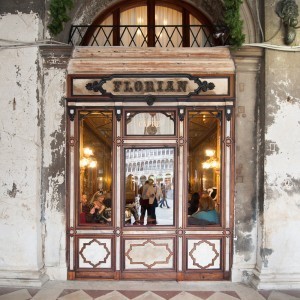 Coffee is wonderfully complementary to the pursuits of reading and writing for the energy and comfort and socialisation it affords. So it’s little surprise that one of the locations of most interest to lovers of literature that visit Venice is a coffee house. But not just any coffee house: the very oldest.
Coffee is wonderfully complementary to the pursuits of reading and writing for the energy and comfort and socialisation it affords. So it’s little surprise that one of the locations of most interest to lovers of literature that visit Venice is a coffee house. But not just any coffee house: the very oldest.
Caffè Florian enjoys a prime position in the heart of Venice, on St Mark’s Square. It was opened in 1720, originally as Caffè alla Venezia trionfante (the Café of the Triumphant Venice), and then Caffè Florian after its founder, Floriano Francesconi. At once it gained a reputation as the place to be seen. Balzac wrote of the coffee house, ‘The Florian is all together a scholarship, a theatre foyer, a reading room, a club, a confessional…’
Along with Balzac, counted among Caffè Florian’s clientele over the years are the following writers: Carlo Goldoni, Goethe, Casanova, Lord Byron, Proust, Stravinsky, Rousseau and Charles Dickens. To take coffee at Florian’s, then, is to sit among the ghosts of some literary greats.
Why did these writers gravitate to the coffee house? For the quality of the coffee, presumably, and for the ambiance of the place. This was a café open to different social classes and, unusually (and excitingly for Casanova!), women. But perhaps the biggest draw has long been the artworks on display there: after all, art begets art. The décor is opulent and sumptuous, and the artworks beautiful and historic, so much so that Florian’s lends out pieces to art museums worldwide. So pivotal a role does Florian’s play in the Venetian art scene that it was the original home of the Esposizione Internazionale d’Arte Contemporanea (International Exhibition of Contemporary Art), which grew into the world-renowned Venice Biennale.
If you are visiting Venice, I highly recommend the café. For those farther afield who’d like to sample some Florian style and gourmanderie, London’s Harrods has a branch, and you can buy delicious teas, coffees and chocolates through the online shop: http://www.caffeflorian.com/shop/catalogo-gourmet-c362.html.
February 21, 2014
Literary Venice Week: ‘Venetian Spell’ by Lady Caroline Blanche Lindsay
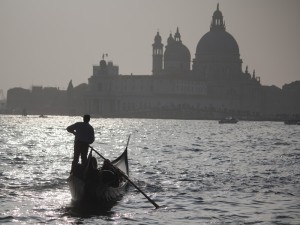 This week I am dedicating my blog posts to the theme of ‘Literary Venice’.
This week I am dedicating my blog posts to the theme of ‘Literary Venice’.
Recently I blogged about Lady Caroline Blanche Lindsay, ‘the epitome of the cultured and fashionable aesthetic woman’ in the nineteenth century, and the writer of a collection of poems on Venice: From a Venetian Balcony: And Other Poems. Today I’m sharing with you one of my favourites. Venice has always seemed to me a magical place, and this poem really encapsulates the ethereal beauty and romantic air of the city, which I so enjoyed describing in The Echoes of Love.
Venetian Spell
O spell of dawn!
From opal skies a roseate mist floats out,
And slowly wraps the towers and domes about.
All Venice sleeps — nay, yonder a black barge
Slides to the open from the dusky marge.
O spell of silence!
Peace of mind and soul — the plash of oars,
Perchance a distant bell from island shores;
Upon the glassy stillness of the mere
No other sound to vex a fretful ear.
O spell of age!
Historic scenes and names and memories
Are bulwarks of the city in the seas;
Each palace is a book, a scroll each wall —
The sculptured poems hold our hearts in thrall.
O spell of night!
First wanness, then the blue, then sudden dark;
Quiv’ring reflection from each tiny spark;
The water makes a mirror for the moon,
The heavens become a star-beflecked lagoon.
O spell of beauty!
Like the goddess of grey legend-lore,
Cypris or Hulda, sung in runes of yore,
She — Venice — binds men with a magic chain —
Her slaves, that gave an hour, through life remain.
February 19, 2014
An island straight out of a ghost story: Venice’s ‘Island of Death’
Venice is a city composed of no less than 118 small islands, and most have their own unique history and feel. Such an abundance of locations within the city gave me a wealth of choice when it came to situating the action in my novel The Echoes of Love, and my heroine Venetia travels to several islands beyond central Venice, such as Torcello, famous for its mosaics, and Murano, known internationally for the exquisite glass produced there. She admires the ancient cypresses of the tiny Isola del Deserto, and goes to a nightclub on Giudecca. But one island that Venetia does not visit – that no one visits with an eager, happy heart – is Poveglia, the ‘island of death’.
Initially, this tiny island, situated between the city and Lido, was a place of sanctuary: in the year 123 AD people made their homes on the island to escape persecution by barbarians. But come the late eighteenth century, the island’s purpose had evolved from protection to segregation: it was designated a place of quarantine for sailors suffering from the contagious plague, a lazaretto. Countless people were confined on the island; for many, it was the last home they’d ever know. Some 160,000 people are believed to have died there. Supposedly ever since fishermen have steered clear of the waters surrounding the island for fear of netting the bones of their ancestors, and the soil of the island is black and ashy from the pyres on which they burned the many bodies.
Come the twentieth century the island was still being used as a place of exile to separate off a section of society: the mentally and acutely ill. According to legend, one doctor of the hospital established on Poveglia tortured his patients before having a breakdown and leaping from the bell tower to his death – a fall he survived, only to be overcome by a mysterious mist. The bell tower has long since been dismantled, but some say they hear still distant tolling from the island.
Today, the island is abandoned, and the buildings on it lie derelict and still. Given its haunting history, Poveglia is now something of a mecca for ghost hunters, and has featured in books and television shows on the theme. But before you grab your ectoplasm detector and charter a boat to take you to the island, be aware that it is closed to any visitor. Because the buildings on the island are condemned? Or because the rumours of a darkness on the island are true?
Either way, I’m sure you can see why I did not send my heroine to Poveglia – then I’d be writing a ghost story, not a romance. That is not to say, however, that no mystery, no darkness, no ghost exists in The Echoes of Love. But I wouldn’t dream of elucidating on that here and ruining the ending of the book…
If you are interested in Poveglia, there’s an interesting article here, and the following video offers a glimpse of the island:
A simple YouTube search also brings up clips from ghost-hunting television shows, if you like that sort of thing!
[CW1]xxx
February 17, 2014
Favourite artist: Paolo Veronese
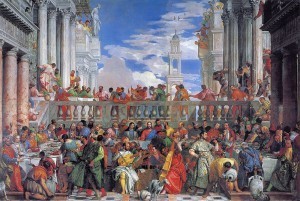 Regular readers of my blog will have spotted a common theme in the sources of my inspiration:
Regular readers of my blog will have spotted a common theme in the sources of my inspiration:
Colour!
And that is, for me, a key reason that I love the vivid artworks of Venetian painter Paolo Veronese. As you can see from the painting I’ve included here, The Wedding at Cana, Veronese was a colourist whose works are full of passion and movement and detail and grandeur that they reach out and grab your attention, demanding to be absorbed and appreciated.
Veronese was an artist of the sixteenth century who, along with Titan and Tintoretto, was one of the leading painters of the Italian Renaissance period. Along with his use of colour, which was inspired by Titan, he is widely known for two elements of his works:
Religious and mythological subject matters: He was especially respected for the biblical scenes he painted for monasteries in Venice and Verona, such as The Conversion of Mary Magdalene and The Deposition of Christ. He gained a reputation as the very finest of ceiling fresco painters.
Vast sizes: The Benedictine monks of the San Giorgio Maggiore Monastery commissioned Veronese to create a 66-square-metre painting: The Wedding at Cana. And The Feast in the House of Levi measured more than five metres high and more than twelve metres wide and was one of the largest canvases created in the world in that century.
The Feast in the House of Levi is remembered for more than its size, however: it earned Veronese an audience with the Inquisition, who took exception to some of the details of what was a Last Supper scene, which included dwarves and a variety of animals. In his defence, Veronese told his inquisitors, ‘We painters use the same license as poets and madmen.’ Rather than repaint the scene to please the Inquisition, he retitled it so that it was no longer a depiction of the Last Supper.
Some interesting facts about Veronese:
He was born Paolo Spezapreda, but he adopted the name Caliari, which was the name of his grandfather, Antonio Caliari, from whom he was illegitimately descended. He signed the name Paolo Veronese for several years on his paintings; Veronese draws on his birthplace, Verona.
Veronese’s brother, sons and nephews worked with him in his workshop, and painted after his death in his style, signing their works Haeredes Pauli (Heirs of Paolo).
If you’re a British reader, or plan to visit London this spring, and you’re interested in Paolo Veronese, be sure to take in the forthcoming exhibition of his works at the National Gallery on Trafalgar Square. The exhibition is entitled ‘Veronese: Magnificence in Renaissance Venice’ and it will run from 19 March – 15 June 2014. If you have time while visiting the gallery, I can highly recommend the National Dining Rooms restaurant there, a beautifully designed space and a fine menu that changes monthly to focus on a different county’s cuisine.
[CW1] Paolo Veronese
February 15, 2014
Book review: The Whispering Wind by Lexa Dudley
From the blurb:
The Whispering Wind is a moving story of two lovers, set on the beautiful island of Sardinia, where Elise goes on holiday to escape a loveless and violent marriage.
Whilst there, she meets and falls in love with Beppe, a local Sard. Despite religious and cultural complications, they embark on a romantic and passionate affair.
Beppe shows Elise his island and introduces her to the welcoming culture of the Sardinians and Elise soon falls under the spell of both the island and its people.
But after weeks of blissful happiness, Elise has to return unexpectedly to England to face all the problems she had been so desperate to leave behind…
When Lexa approached me to enquire whether I may be interested in reviewing her novel, my answer was an easy ‘yes’. Romance set on Sardinia? Right up my street, especially given the fact that my own latest novel, The Echoes of Love, is a romance set in Venice, Tuscany and… Sardinia! I love the setting – Sardinia is quite one of my favourite places for its unspoilt beauty – and so I was very keen to read this novel.
I knew from the first paragraph that the book would not disappoint:
A gentle breeze fluttered through the peach grove, but gave no respite from the midday sun. The rows of peach and olive trees offered no shade, and the branches of the tall cypress trees surrounding the orchard seemed to trap and intensify the relentless rays, creating an overwhelming heat that pervaded everything. Only the strident call of the cicadas broke the unnerving quiet that descended over the dry land.
I adore the author’s writing style; her ability to evocatively convey the setting. There is so much colour and passion and feeling in her writing: she’s a romance writer par excellence.
The story drew me in from the beginning, so much so that I read the book in just two sittings – I couldn’t put it down. I love the characterisation, especially of the local Sardinian people. I love the depth to the character of Elise and her journey to find herself, and to heal her heart, after her abusive marriage. I love the hero of the book, Beppe, and find him so real as a person that he seems alive beyond the words on the page. I love the development of Beppe and Elise’s relationship, and the attention the author pays to exploring their feelings.
No doubt you’re spotting a theme: I love this book!
I’ve no wish to provide a spoiler of the ending here. Suffice it to say that it surprised me, and moved me, and is, I think, a very mature and intelligent close to the book. I’d have loved more depth at the end; more exploration of Elise’s life when she returns to England, and Beppe’s respectively. But I see why the author has written the book as she has.
In all, this is a book that stayed with me after I read the final words, and is one I think I will re-read in the future. It’s certainly made me pine for beautiful Sardinia!
I very much hope Lexa has more books in the pipeline: I will be first in line to read her next release.
The Whispering Wind is available now from Amazon; click on the book cover below to visit the store.




